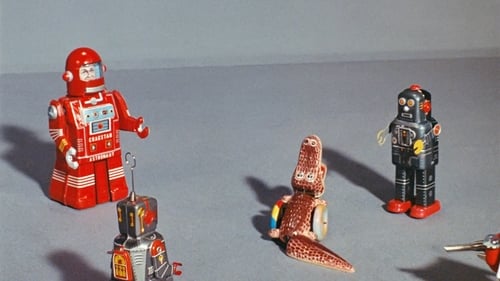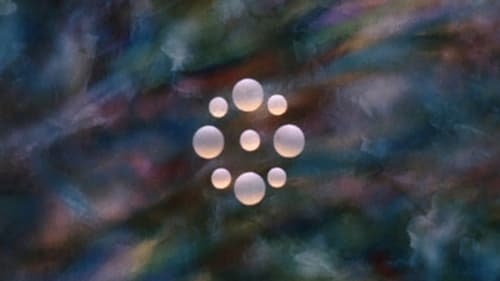Hen Hop (1942)
Gênero : Animação
Runtime : 3M
Director : Norman McLaren
Sinopse
This joyful short animation features a dancing hen that transforms into an egg. The film was made without a camera by Norman McLaren, who drew directly onto 35 mm movie stock with ordinary pen and ink. Colour was added optically.

In this early film Norman McLaren shot crystal formations through a low-power microscope, using polarized light with the lower part of the picture masked off. The film was then rewound and a scene of dancers was filmed.

Taking "Isle of the Dead," a work by the Swiss symbolist painter Arnold Böcklin as his starting point, Norman McLaren creates a deeply disturbing surrealist dream.

This publicity clip for Canada Post is Norman McLaren's first film for the NFB. For this animated short, McLaren drew symbols by pen onto clear 35 mm stock, which was then superimposed on a photographed painted background. Benny Goodman's rendition of Jingle Bells provides the accompaniment. (NFB)

An oddball pair try to find their identity and place in an abstract world.

A slow-motion study by Norman McLaren of the pas-de-deux adagio, one of the most exacting and difficult dances of classical ballet. A ballet originally choreographed by the Russian ballet master Asaf Messerer is performed for this film by the internationally known Canadian pair, David and Anna Marie Holmes, to the music of Albinoni’s Adagio. A film to heighten the aesthetic appreciation of classical ballet and to afford observation of the technique and mechanics of the adagio movements.

Carmencita Garcia, a Spanish flamenco dancer, performs two dances.

A gay fantasia of patterned sound in which Norman McLaren salutes the West Indies, painting the spirit of fiesta on film to the lively beat of an island tune by Trinidad's Grand Curacaya Orchestra.

An animated film in which colored shapes dance to calliope music. The visuals were drawn by Norman McLaren directly upon the film with pen and ink. Simple forms dance about the screen to the discordant strains of an old-time circus calliope.

New Yorkers watch as Norman McLaren's animated promotional film for Canadian tourism plays on the giant pixelboard overlooking Times Square. The caption below the board reads: "Canada... Wonderful World At Your Doorstep". McLaren himself is a member of the crowd.

Three separate sequences related to Christmas, animated in different styles: cutout animation of children dancing in the snow to "Jingle Bells," stop-motion animation of toys come to life, and cel animation of a man who seeks the ideal star to top his Christmas tree.

This short film made by László Moholy-Nagy is based on the shadow patterns created by his Light-Space Modulator, an early kinetic sculpture consisting of a variety of curved objects in a carefully choreographed cycle of movements. Created in 1930, the film was originally planned as the sixth and final part of a much longer work depicting the new space-time.

One of Oskar Fischinger's earliest films, Seelische Konstruktionen (as it is known in German), clearly points the way to the masterpieces of musically-blended experimental animation he would conceive in the decades to come. The sense of masterful timing and rhythm, the easy and natural -- though patently Fischinger-esque -- character traits of the subjects, and the smooth precision of both line and movement are all present already. Unique is the black-silhouetted, semi-cartoon characters (not nearly as rigidly self-contained as Lotte Reiniger's cut-out forms) which seem to adhere to no physical limitations whatsoever. Morphing into shapes, structures, objects, patterns, and even one another, as though they were made of pure mercury and set to music. As for the "story", it's rather non-sensical, and certainly silly, but also has a slightly dark and devious tinge to it as well; men becoming monsters, uncontrollable shape-shifting and the constant, almost desperate movement.

Stars and stripes forever and ever and ever.

A man visits the panels of a comic page-like world in search for his loved Gloria.

An early experiment in employing computers to animate film. The result is a dazzling vibration of geometric forms in vivid color, an effect achieved by varying the speed at which alternate colors change, so producing optical illusions. In between these screen pyrotechnics appears a simple line form gyrating in smooth rhythm. Sound effects are created by registering sound shapes directly on the soundtrack of the film.

A tribute to the human body.

This animated short is a play on motion set against a background of multi-hued sky. Spheres of translucent pearl float weightlessly in the unlimited panorama of the sky, grouping, regrouping or colliding like the stylized burst of some atomic chain reaction. The dance is set to the musical cadences of Bach, played by pianist Glenn Gould.

Inflation (1928) is an experimental silent film at eight minutes which is sometimes categorized as a documentary. By now Richter is well beyond playing with light & shadow. Inflation explores the subject of money through photographs & with with stop motion animation techniques, adding faces of people impoverished & enriched by the unpredictability of finance. It functions almost as a political cartoon in motion, building to a chaotic & catastrophic climax.

Hot Breath Harry is a hot trumpeter at a jazz club. He finds himself drafted into the Army, where he's assigned to be the bugler of an African-American company. But everyone hates the bugler, because he blows reveille at the ungodly hour of 5 AM sharp.

In 1944 Lye moved to New York City, initially to direct for the documentary newsreel The March of Time. He settled in the West Village, where he mixed with artists who later became the Abstract Expressionists, encouraged New York’s emerging filmmakers such as Francis Lee, taught with Hans Richter, and assisted Ian Hugo on Bells of Atlantis. Color Cry was based on a development of the “rayogram” or “shadow cast” process, using fabrics as stencils, with the images synchronized to a haunting blues song by Sonny Terry, which Lye imagined to be the anguished cry of a runaway slave. —Harvard Film Archive



